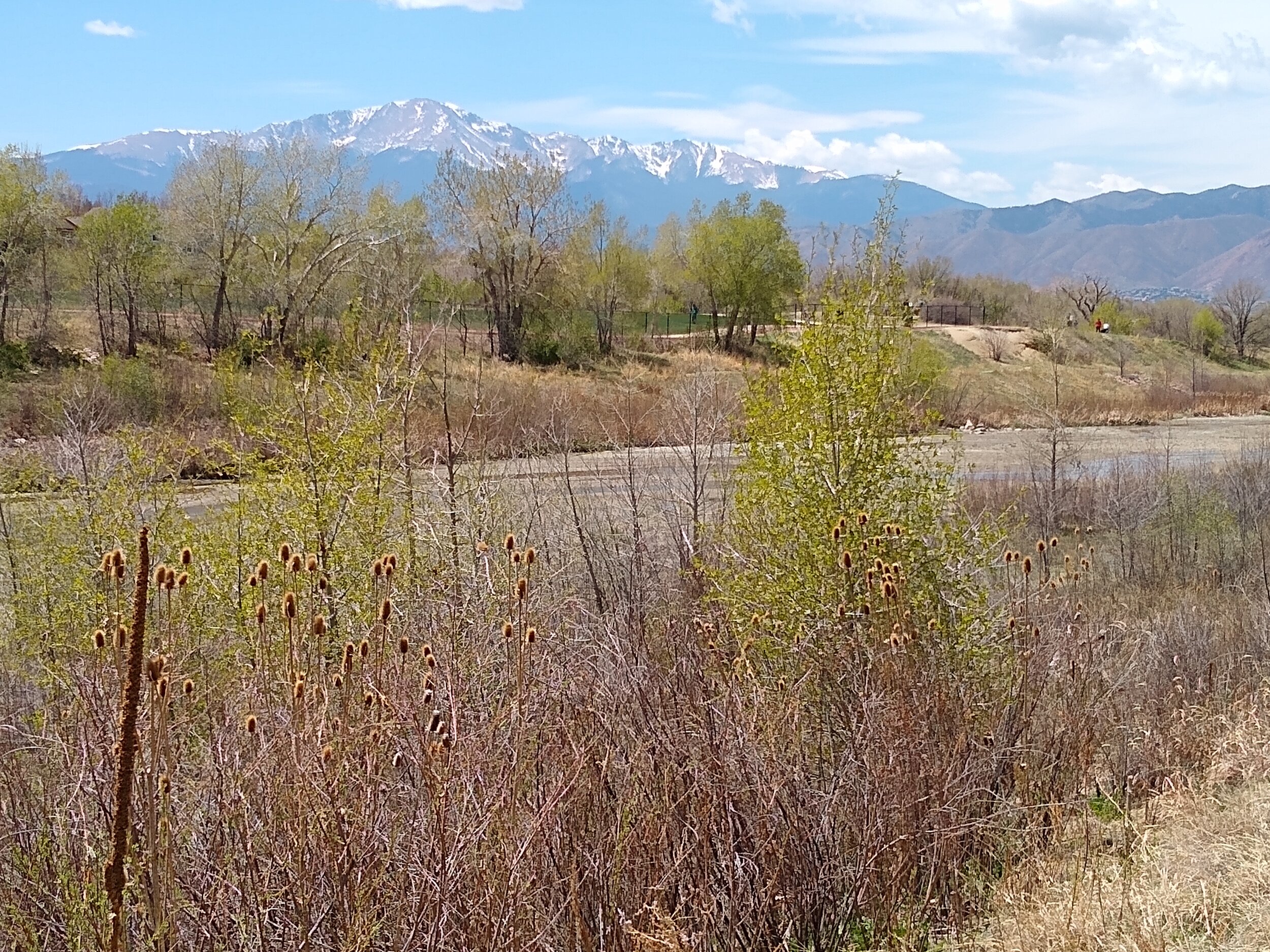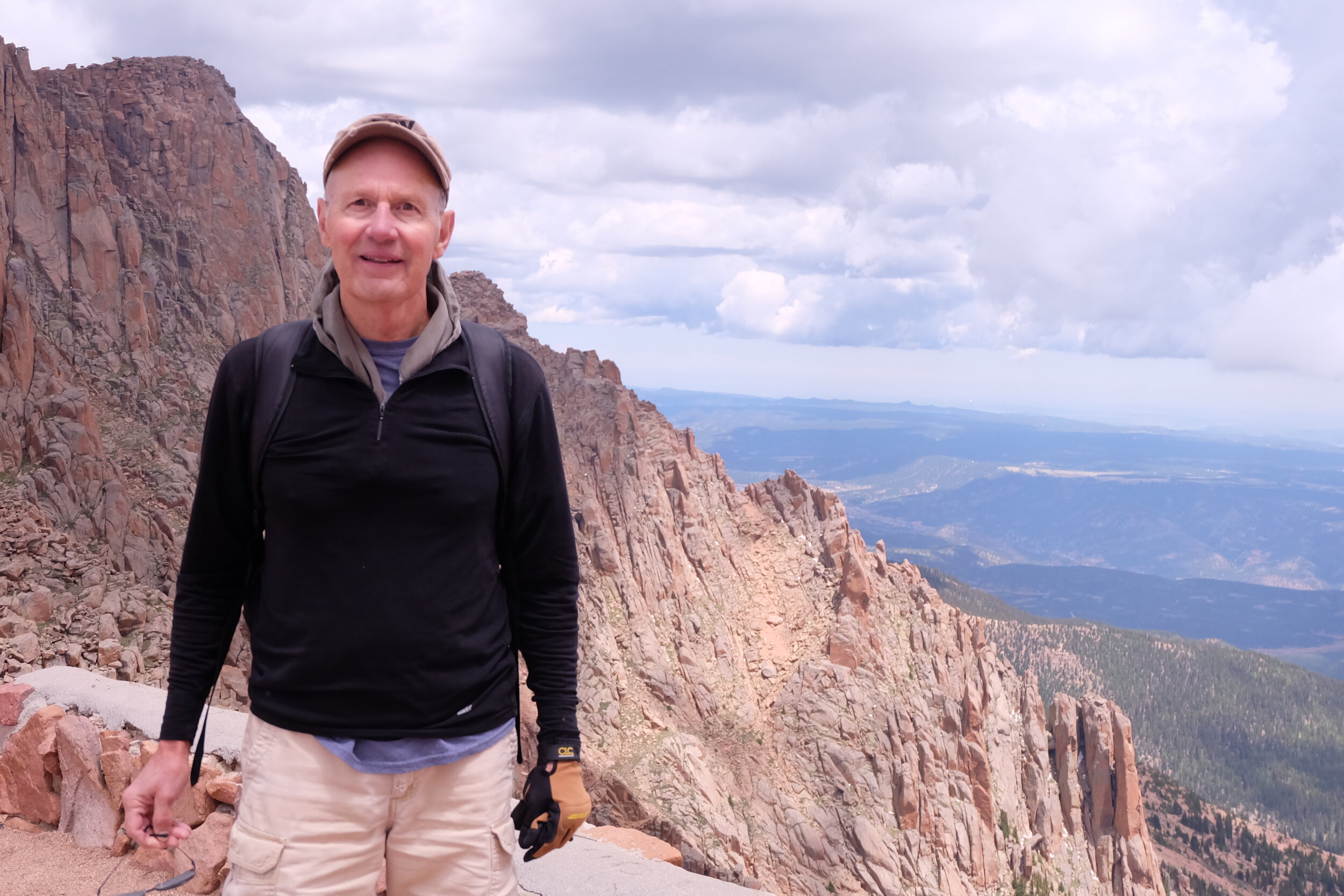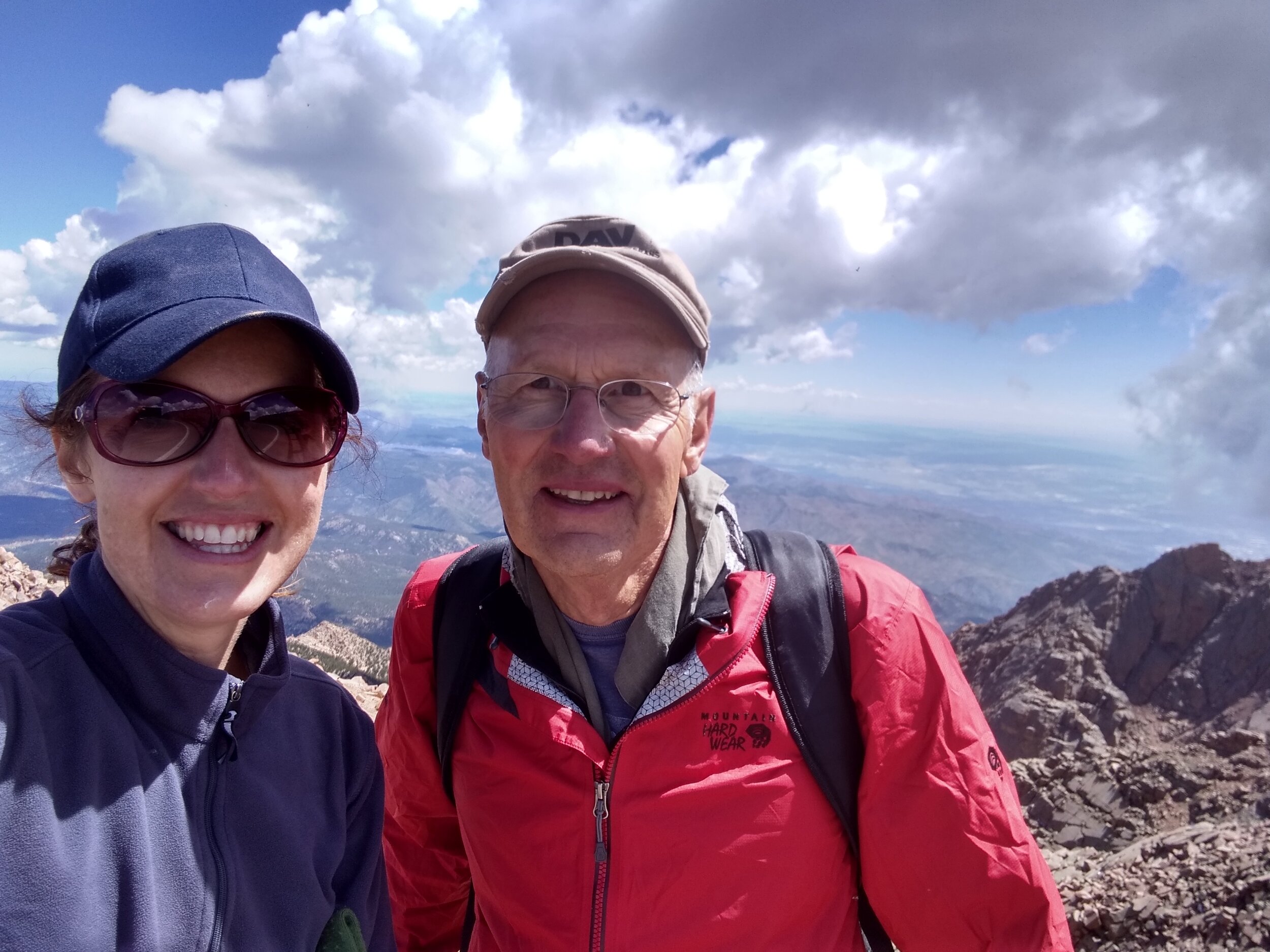The first time I saw Pikes Peak, I was disappointed.
I thought it looked a little small. I was 16 and I’d just ridden into Colorado Springs from New York in our packed-full-of-our-possessions van and I already missed the green forests and my friends and the Army that I’d left behind. I guess this 14-er—as mountains that are over 14,000 feet tall are called here—wasn’t enough to replace what I’d just lost.
But the first time I hiked it, (a year or two later, I think?) I figured out it was almost more than I could handle. Thirteen miles up via Barr Trail, I can still picture some of those steps around bends, through forests and up above the trees and over piles of rocks. Every single step a step not just forward but relentlessly up. I had never before hiked at such high altitudes. But those views along the way got better and better. And the top? With nothing but sky above me and its clouds below me and waves of mountains west and shiny dots of city east and wobbly victorious legs underneath me? More than I could’ve imagined.
The second time I moved to Colorado—just last year—and saw Pikes Peak through our airplane window, I was numb. This had been a home and might possibly become a new home but I felt like I’d entered a story I never wanted to tell or live. Our flight operations in Indonesia had just closed due to circumstances beyond our control. The plane we’d worked for, prayed for, sacrificed for, was gone. The needs remained, but with no one to fly.
I felt heartbroken, disappointed, misunderstood, disillusioned, voiceless and purposeless. And I was returning from the great adventure in a way that felt more like defeat than completion. I’d lived as courageously as I could but it still wasn’t enough. I didn’t know how to move forward. I didn’t even want to move forward.
The flight attendant on that small plane into Colorado Springs kindly asked, “Is this home for you?”
I hesitated, then nodded. The nod was less of a choice or a certainty and more of a way to avoid a conversation I didn’t know how to have yet. Was it home, back when this was the place we moved upon my dad’s retirement from Army life to join a ministry? Back when I was stepping out of one lifelong culture to enter another? Did it become home for those two years of high school before I jetted off to college back east, and then eventually to another three states before heading overseas to Indonesia? Was it home now?
“Well, welcome home, then,” she said.
It was the perfect thing for her to say to me after I’d lived 14 years on the other side of the world, followed by another eight years of living in other places. It had taken us two or three long flight days to get to Colorado from Indonesia and the weeks before that were just as grueling. The plumeria bloom I’d placed behind my ear at the start of our flight in Jakarta was long wilted. And at the time, her words weren’t enough of a welcome at the time to overcome the losses. But I tucked her thoughtful sentiments away—actually wrote them down later in my journal—for when I could pull them out someday and believe them.
Last year, under the shadow of that mountain, we processed, made choices, bought possessions to replace ones we’d left behind, and eventually decided to, in fact, make Colorado our next home. And one day in summer 2019, I decided that I wanted to look back at the difficult year of transition from the top of Pikes Peak. Summer 2020, I told myself, I’d hike it again.
The last time I’d hiked it was probably some 20 years before. Before I turned 40. Before I had three kids. Before trauma. Life had filled with so much good and so much hard in those 20 years, I wondered what it would be like to hike it now, carrying all of it in my bones.
For various reasons, Brad couldn’t go with me. (We’ve hiked it together years ago.) But my dad, who just turned a very respectable 70, was game.
Once we picked our day in June, Dad reminded me of some things to pack—high protein snacks, lunch, plenty of water, a rain jacket, sunscreen, a hat, gloves, extra wool socks, warm layers. I made sure I had my nice camera with me. I threw my driver’s license and credit card into my camera bag so we’d have ID and a money source, just in case we needed help. The trick, the hiking sites say, is to pack everything you need but not too much that it weighs you down.
I’d always hiked the mountain from its eastern side via Barr Trail—the side next to the city of Colorado Springs—starting at about 6,700 feet. It’s a popular route. Parking at its base is hard to find. It’s also its longest route—13 miles up. Many people only have time to hike up before the afternoon thunderstorms make the descent dangerous, and so they get a ride or take the cog railroad down. But with the pandemic, we were trying to avoid a crowded route. Plus, the cog is temporarily closed. Besides, it could be interesting to try a new way.
We settled on its “back” route via Crags Trail and then Devil’s Playground—which starts at a higher altitude of 9,900 feet and with a shorter route up of 6.5 miles, and therefore, the stronger chance of being able to do a total 13-mile out-and-back hike in one day. Besides, the views along the way face west and its glorious Rockies.
Dad and I chatted during the hour-long drive there, but once we hit the trail in the early morning dark, we fell silent. We were starting at a breathtakingly high altitude and I knew we’d have to keep a fast pace. I focused all my energy on that. The day started chilly, but by the time we’d reached the first vista, the sun was rising and I peeled off my outer layer. I pulled out my camera and snapped shots of soft fog clinging to the strong, resolute mountains.
We kept going, pushing our lungs in the thinning air, stopping for short breaks and to look at wildflowers, marmots, deer. We saw few people. By the time we moved out of the Crags Trail to Devil’s Playground, the fog had burned off, the sky emerged big and blue and I got shots all around us of towering rock formations, distant streams and more wildflowers lining our way.
“It takes a long time for these flowers to grow in this tundra,” Dad said.
I wondered at all they’d survived to bloom that day. And I remembered learning when I first moved to Colorado at 16, that it’s illegal to pick flowers in state parks in Colorado so as not to damage the ecosystem. Also, many are rare and protected by the state. I made sure not to step on them. And I decided to feature them—their mixture of resiliency and fragility—in the foreground of my shots. Maybe the flowers—not the mountains—were what was strongest up here.
I’d decided this would be a contemplative hike for me, that I’d let myself think, not just on the last year, but on everything that led up to our departure from Indonesia. So, I hiked and remembered. I hiked and argued. I hiked and grieved. I hiked and gave thanks.
I recently came across my journal entries I wrote as we were preparing to leave Indonesia.:
“We told our kids yesterday that we'll be moving away from Indonesia,” I wrote in March of 2019. “It was heartbreaking. They're thinking of their friends, their cat, this country, the zip line in our yard. My 10-year-old son asked, ‘Will we ever get to come back to Indonesia?’ I took a minute and added up the cost of tickets for five for a visit sometime--$5,000-6,000. But then I realized that so many other things can't be added up, saved, purchased. Even if we come for a visit someday, we won't get our house back, our cat back, our life back. My kids may not remember the language from here to be able to talk with their beloved friends.
“Last night, we met with Indonesian and American teammates here (who are wonderful and part of the healthiest team we've ever been on). They were amazingly supportive, grieved with us, encouraged us. Flight requests keep coming in and our team has to tell them that their pilot has to go and that they will have to find another way to get to their remote jungle home. The losses aren't just our losses with this decision. I can hardly breathe for the losses.”
The last part of ascent, we faced a boulder field. The thinning trail was marked by intentionally stacked rocks that soon lost their distinction among all the other rocks. Partway up, we couldn’t find the trail, so we scrambled up with hands grabbing for rocks, feet wedged in crevasses, backpack falling against my bent neck. I felt stuck, staring at jagged rocks right beneath me, not daring to look down at the steep decline, not trusting the look up at false summit after false summit. It reminded me of other times when I’ve felt trapped with no clear path, no way out but up. With Dad just in front of me, I pressed on.
With shaking legs, we finally summited to see noisy construction of a new visitor’s center, and summer tourists (who had driven up,…those posers) wearing masks and shorts despite the windy, chilly temps. We were done with the vicious ascent and I soaked in the freedom of escaping the boulder field. But mostly, I was too tired from the effort and disoriented at the sudden busyness of the scene to celebrate what we’d accomplished. I just wanted to find a warm place in the old, but open visitor’s center to sit and eat my smooshed PBJ. We waited outside the door in line with masks, due to social distancing occupancy restrictions, only to enter, then find all tables and chairs roped off. We had, after all, hiked the 14-er in a pandemic.
We went back outside and found some rocks to shield the wind, crouched, ate, then, without much discussion, started our decent. You’d think going down would be easier than going up, but our legs were tired and wobbly and I just wanted to be done.
Past more marmots and wildflowers and vistas, we kept going. The last hour or two were the hardest for me. I knew we were getting close, but not close enough to be able to just skip down the mountain. The afternoon storm clouds were starting to form just as my legs gave out. I slipped and slid down part of the path. We took a break—water, snacks, several deep breaths. Down we walked again, passing a handful of hikers who must’ve been hiking the lower Crags trail only due to the late hour. Finally, we made it to the car just as the rain started. Dad drove home. I napped.
It should’ve been over and definitely time to celebrate when he dropped me off at my house. But as I started to unpack, I realized something. My camera bag—with my driver’s license and credit card in it—was missing.
For part 2 of this story, come back tomorrow.






